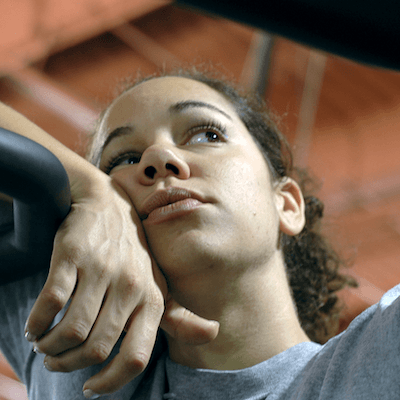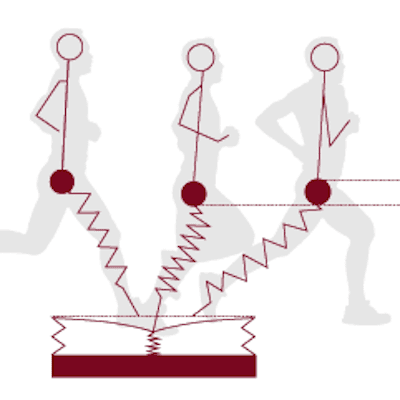


Rich Kite1 and Jourdain Benstead-Banthorpe2
1Department of Rehabilitation and Sport Sciences, Bournemouth University, Bournemouth
2 Higher Education Sport, Loughborough College, Loughborough
The popularity of plyometric exercises highlights the critical role that they play in developing athletes within strength and conditioning practices. However, although a staple exercise of the strength and conditioning practitioner’s toolbox, plyometrics are all too often overlooked, resulting in practitioners not reaping the most benefits from their application. This article attempts to provide more clarity and guidance towards the use of plyometrics with the aim of improving practitioner application and understanding. This includes building a greater understanding of plyometric adaptations, as well as an awareness of movement strategy, exercise prescription and exercise progressions.
Plyometric exercises are widely used within strength and conditioning (S&C) practice to develop speed, power, landing mechanics, and injury resilience.37,38 Although increases in muscle cross-sectional area are commonly reserved for traditional resistance training, plyometrics will provide sufficient stimulus for hypertrophic adaptations.10,22 However, the use of plyometric training is more broadly applied to enhance mechanical efficiency and neurological response, ultimately aiding sporting performance. Therefore, the aim of this article is to outline and educate practitioners about the mechanisms applied within plyometric training; we will also provide practical guidance for programming and application.
A key characteristic of plyometric training is the rapid stretching/lengthening of the muscular tendinous unit, followed by an immediate contraction/shortening of the muscular tendinous unit. This sequence of events is known as the stretch-shortening cycle (SSC), which is a predominant feature of majority sporting movements (running, jumping, throwing, kicking, etc). During the lengthening phase of the SSC, elasticity (elastic energy) is produced within the muscle and tendon (more so in the latter), which in turn is postulated to aid force production. However, an ongoing debate remains around elasticity and its contributions, which is beyond the scope of this paper.39
Generation of elasticity is believed to be proportional to the size of the stretch placed upon the muscular tendinous unit.33 Therefore, the more strain created, the greater return of energy. As the muscular tendinous unit shortens, elasticity then contributes to force generation, resulting in increases in jump height, running economy, among a host of similar movements.33 Additionally, the generation, storage and release of elasticity has been associated with muscle stiffness and tendon compliance.24 As the tendon can provide up to four times more elastic energy storage than the muscle, being the more compliant of the two is essential.3 However, it should be noted that the amount of compliance of the tendon is task-specific,3 as an under- or too-compliant tendon (not enough/too much deformation) could result in suboptimal force transfer.
In simple terms, when you consider the effort required to stretch a thin resistance band (low effort), compared with that required to stretch a thick resistance band (high effort), the energy return is greater from the thicker band – albeit disproportionate to the effort. However, a critical threshold exists whereby energy return reaches a ceiling, and additional strain placed upon the muscular tendinous unit will no longer aid force production.33 Given the significant role of the SSC in highly dynamic and sporting actions, the utilisation of elastic energy found in plyometric exercises is believed to enhance mechanical efficiency of movement: this, therefore, positively transfers to the improved economy of sporting performance.24
Plyometric exercises are typically categorised into two groupings relating to ground contact time (GCT): fast SSC (GCT = <250ms) and slow SSC (GCT = >250ms). Given the speed of contractions, as specifically highlighted in fast SSC, there is a demonstrable need for heightened neurological capacity. Neurological adaptations to plyometric training have been linked to enhanced excitability of the stretch reflex, the desensitisation of the Golgi-tendon, and increases in neuromuscular pre-activation.5,25 These changes are associated with the stiffness in muscles, thereby increasing elastic energy. Likewise, plyometric training has also been associated with improvements in motor-unit recruitment and action potential frequency and amplitude,21 suggesting the speed of a neural stimulus informing a muscle to contract is faster, at a greater rate, and is able to co-contract more motor-units in synergy.
Given the above mentioned points, plyometric training serves to enhance athletic potential via mechanical and neurological adaptations, and the authors encourage its utilisation within strength and conditioning provisions. However, practitioners must be mindful as to how plyometric training is applied, as several pitfalls have been repeatedly observed hindering athletes’ adaptation and athletic progression.36 Therefore, this article serves to raise awareness of common errors observed using plyometric exercises, and provide general guidance and considerations about the use of plyometric training for successful sporting transfer. The three main topics of focus will be: 1) movement strategies; 2) exercise prescription; and 3) practical considerations.
Plyometrics are often under-estimated because of their complexity to execute meaningfully – ie, ensuring the correct stimulus and adaptation takes place. Failure to consider technical models of execution may result in sub-optimal transfer and time wastage (and time is a vital commodity within S&C). The goal for most plyometric activities is a reduction in ground contact time and/or high instantaneous force generation. However, a common focus on jump height as a proxy can be misleading, given that research has identified different strategies capable of achieving improved jump heights. For example, research by Makaruk et al17 looked at attentional focus and its effects on plyometric performance. The findings illustrated an improvement in jump height through a range of strategies: 1) an increase in knee flexion (and consequently a higher ground contact time and poorer use of the SSC); 2) an increase in force production; and 3) an increase in force production and reduced knee flexion (reduced ground contact time, increased stiffness and enhanced use of SSC).
Further support has been established investigating the kinematics of various jumps,15 whereby participants were asked to execute shallow and deep jump variations. The outcome highlighted the differing strategies applied, with the deep jump of note exhibiting a positive jump height, and yet with excessive ground contact times, hindering the use and development of the SSC. Therefore, purely monitoring jump height alone can be problematic in ensuring correct adaptation and movement application is being attained.
When considering technical positions within the plyometric movement, a commonly discussed element of plyometrics is foot contact position and how the foot ‘attacks’ the floor. Coaches often instruct athletes to either 1) plantar flex at the last moment prior to ground contact, slapping the ground on impact; or 2) remain in a dorsiflexed ankle position throughout the movement. When investigating both methods,19 it was established that both interventions resulted in a plantar flexed contact position, albeit a slight angular reduction in the dorsiflexed group. Yet, differences in performances were marginal. Interestingly, what appeared to be a more critical findings was the use of the cue to ‘get off the ground as fast as possible’, over mechanical strategies. Therefore, coaches need to be cognisant of both elements, without an over-emphasis on kinematic positions.
A final movement strategy to discuss is the benefit of using external apparatus to enhance jump performance. Investigations into the kinetic and kinematic differences between external targets (Vertec device or hurdles) and a control group (no apparatus) established optimal performance in the use of an external target.26 The lowest ground contact times and reduced knee and hip flexion were produced when jumping over hurdles (a stiffer strategy required due to the need to flex the limbs immediately to clear the hurdle). However, contrasting findings in the Vertec group were established, producing performance outcomes not too dissimilar to the control group. Such findings may be postulated as the Vertec providing an external stimulus to ‘jump higher’ (eg, a motivational prompt), whereas the hurdle places a biomechanical demand in order to clear the hurdle (eg, constraints based). This is partly supported by further research,12 which established that strategies may be adjusted based on the apparatus applied. For example, in one study,10 the countermovement depth was different between apparatus (box jump and hurdle jumps) and non-apparatus movements (countermovement jump), although propulsive variables were largely equal across groups. Therefore, practitioners should be mindful towards potential changes in strategy when using (or not using) apparatus when using plyometrics.
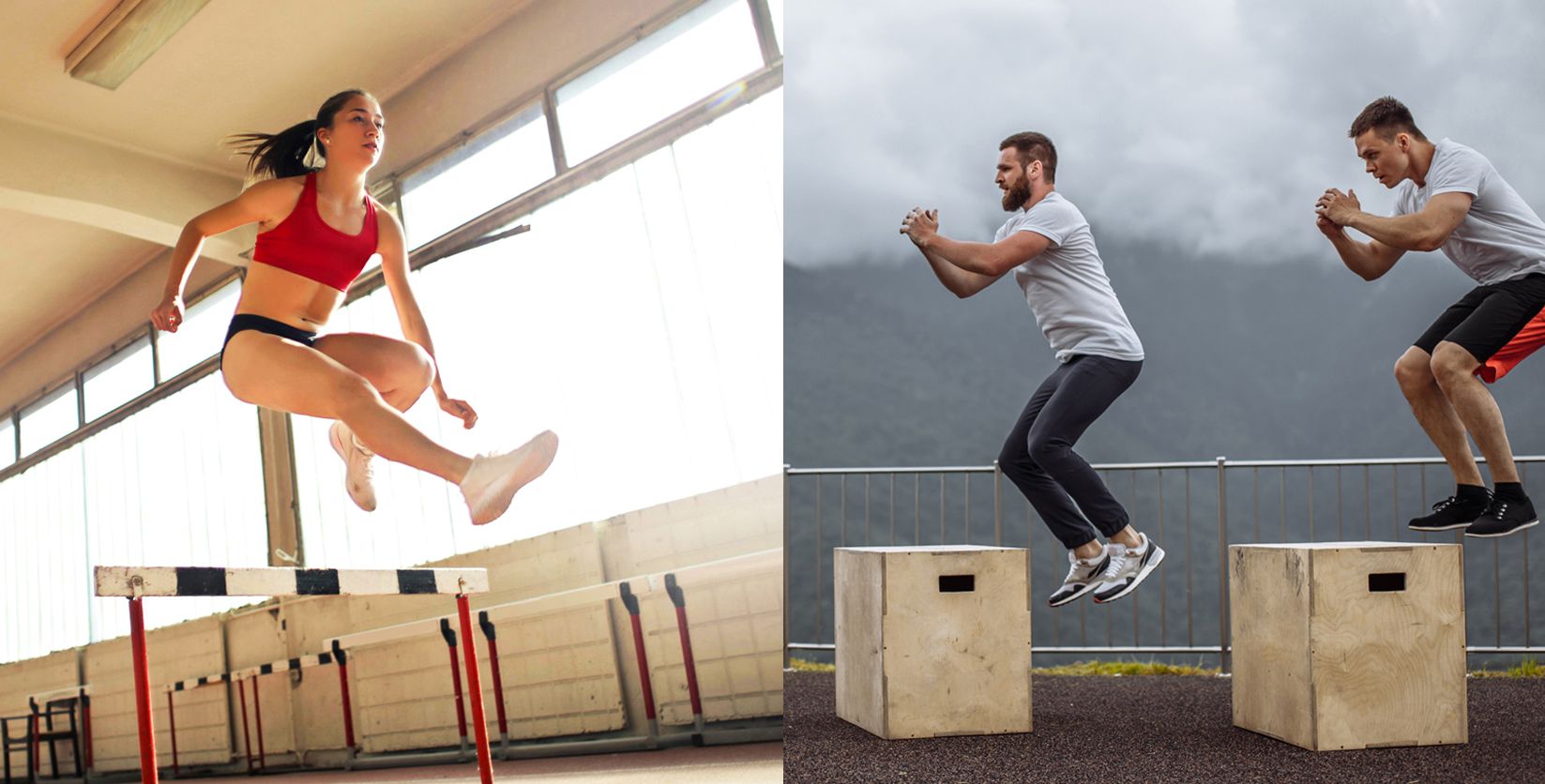
Strength and conditioning coaches will typically create programmes depending upon their individual philosophy towards training, access to athletes, and available resources, among a variety of other considerations. Therefore, coaches may choose to integrate plyometric training with weight bearing exercises (ie, hypertrophy and maximal strength training exercises), or run a plyometric session in isolation (among other alternative options).
In consideration of integrated training, traditionally, plyometric training is organised within the training session near to the beginning (including within the warm-up), when the athlete is most fresh. Such organisation concerns surround the notion that stress invoked from resistance training exercises (ie, weight bearing) will impact the neuromuscular demands and mechanical ability (ie, fatiguing the system beyond an optimal status).4 Therefore, the execution of plyometric exercises is believed to be negatively impacted or hindered by fatigue, resulting in new movement strategies (eg, compensation patterns) applied to execute such movements.
Upon reviewing recent research, Van Den Tillaar31 claimed to find little difference in organisation of training (eg, plyo-strength or strength-plyo), yet noted that the organisation of training had emphasised the overall adaptation achieved (although only acutely). Similarly, Alemdaroǧlu et al1 investigated differences in traditional (plyometrics first), complex (paired: plyometric and then resistance exercises) and contrast (paired: resistance and then plyometric exercises) organisations, establishing advancement in plyometric and strength capacities in each method. Further, Deutsch and Lloyd7 reported the combining of plyometrics and resistance training invoked similar response to training both elements in isolation, yet providing an arguably more efficient use of available training time. Moreover, although the traditional structure appears to be beneficial (and arguably producing marginally better responses within all the above research), there does appear to be merit in the use of the complex or contrast training methods to optimise the programming of plyometrics – and, arguably, efficient use of time.
A potential limitation towards the research mentioned above is the limited variation in plyometric exercises used, typically confined to more simplistic movements. Therefore, as plyometric exercises progress, physical demand equally progresses, which potentially challenges some of the above findings. Moreover, caution must be taken in applying complexes with more advanced plyometric movements (such as ballistics), until further research has explored and identified the benefits or pitfalls.
Outside of sessional organisation, long-term organisation (ie, the application of periodisation) has been discussed by Sole;32 this paper briefly discussed how plyometrics proceeding a strength training phase (ie, following a more traditional linear model) will have greater performance benefits, due to enhanced motor unit activation, increased stiffness in the muscular tendinous unit and, therefore, reduced risk of injury. Although such reporting is associated with traditional linear periodisation methods, such organisation is likely to be transferable to models such as block training – but further work needs to be done to understand the application in models such as undulation, concurrent and conjugated (to list a few). However, it is arguable that bigger issues are more noteworthy at a microcyle level with regards to dosage prescriptions (discussed below), which must be addressed prior to macrocycle application/concerns.
Prescription of volume for plyometric exercises consists of two elements. The first considers minimal dose response – eg, the total quantity of reps required to invoke adaptation. The second considers the appropriate programming of repetitions per set, a critical factor towards optimising outcomes.
Dosage is all too commonly taken for granted, and comprehension towards whether the prescribed dosage is sufficient to invoke a stimulus to demand adaptation (ie, achieving a dosage response) is often overlooked, particularly in respects to plyometrics.36 Firstly, practitioners must consider the metric utilised in the measurement of volume for plyometric exercises. Some practitioners have utilised distance as a prescribed metric. However, as outlined by Sole, via Turner and Comfort,29 this is highly problematic due to the varying anthropometrics athletes exhibit and differing plyometric competencies of athletes. As an example, a more competent athlete may achieve two less horizontal jumps than a lesser competent athlete, both covering 10 metres. Therefore, a common metric applied is the quantity of ground contacts performed. This ensures all athletes are able to accomplish the same desired quantity of jumps, further aiding dosage response (and adhering to progressive overload). The most commonly cited research20 investigating dosages typically points to sessional prescriptions as follows: beginner = 80 to 100 contacts, intermediate = 100 to 120 contacts, advanced = 120 to 140 contacts. However, recent research35 has established lower sessional dosage (40-60 contacts, twice a week) of plyometrics to remain effective in stimulating adaptations. Yet, not all exercises are made equal, and lower level plyometrics may warrant greater quantities of volume, whereas more complex variations lower quantities.20

Although the totality of volume required has been outlined above, the distribution of this volume is equally important. Understanding how many repetitions a unique exercise should demand is not well discussed among the literature. However, through the process of deduction, we can conclude that less intense exercises (eg, pogos) can accumulate higher ranges of repetitions (eg, 10-12r), whereas greater intensity and more complex movements (eg, drop jumps) should utilise lower quantities of repetitions (eg, 3-6r). Failure to adhere to such logic may result in a detriment to technical execution (introducing the ingraining of poor habits) and the failure to create adaptation of the SSC and neurological qualities as expected.
When considering the quantification of plyometric exercises, several authors have investigated and compared variations of plyometric exercises. Jarvis et al13 investigated common exercises (countermovement jump, drop jump 30cm and 40cm, rebounding jump, hop, rebounding hop and step hop), finding impulse to be a superior metric to ascertain the session intensity of plyometrics. The impulse component parts need to be accounted for in order to give context as to how the plyometrics have been achieved, as these could be more muscle or elastic driven, depending on the time in which the SSC occurs. However, given the demand of resources (eg, force plates) in order to monitor impulse, which may not be readily available for all coaches, the use of contacts and applying logical considerations towards the exercise prescriptions seems appropriate.
When we consider high intensity plyometrics, exercises such as depth and drop jumps are usually at the forefront of the mind. A commonly utilised way to account for intensity in these exercises is the measurement of the box height utilised (and logic would dictate this being true for box jumps). However, a limit has been established on how high a box can be increased (assumed to be increasing intensity) until a detriment in performance occurs.2 This ‘ceiling’ happens due to an inability to continually perform the exercise optimally, thus highlighting an incapacity/inability to maintain muscular stiffness and therefore reducing the transfer of performance.
Alternative plyometric movements, that do not require a box, have also been used to quantify intensity. Force plate variables, such as ground reaction forces and rate of force development, have been able to determine intensities across different exercises,6 as has surface electromyography equipment.2 Although consensus is yet to be attained, research13,14,34 has demonstrated a theme of lower ranked and higher ranked intensity exercises, which largely complement current guidance previously provided.8,28 Ultimately, this guidance allows practitioners to acknowledge which exercises are considered more or less intense without a need to assess this directly (given that force plates are often a luxury), offering valuable insights towards programming.
Although recent novel methods in measuring intensity have been established,11 practitioners should have reservations about the implementation of these provisions, based on the lack of validation or reliability assessments. The ‘plyometric stress index system’ utilises video capture (demonstrated with a smartphone), highlighting the mass application that can be applied within. However, this novel method has acknowledged variations in how they determine high, medium and low plyometric exercises, compared to current plyometric guidance, outlining the potential issues with its implementation.
Interestingly, research23 has investigated the programming of intensity within plyometrics, whereby participants were required to perform the countermovement jump within either 90-100%, 70-80% or 50-60% of maximal jumping ability (with an additional control group). The outcome established that all groups improved compared to the control, with the best improvements observed in the maximal group. Therefore, within exercise effort should be maximal. However, it is important not to confuse effort and intensity, as the most intense exercise doesn’t necessarily trump lesser intense exercises; previous research30 has also established similar improvements can be established in using exercises with differing intensities.
A pertinent point to account for is the increase in exercise selection accounting for competency. Although we have some understanding around exercise complexity/intensity (ie, which plyometric movements are more intense to undertake), as discussed in the following section, we must also consider an athlete’s competency to optimally execute the movement (eg, planned versus actual ground contact times). Failure to do this will result in a potential reduction in intensity, due to an incorrect movement strategy being employed. Consequently, suboptimal adaptations will occur.
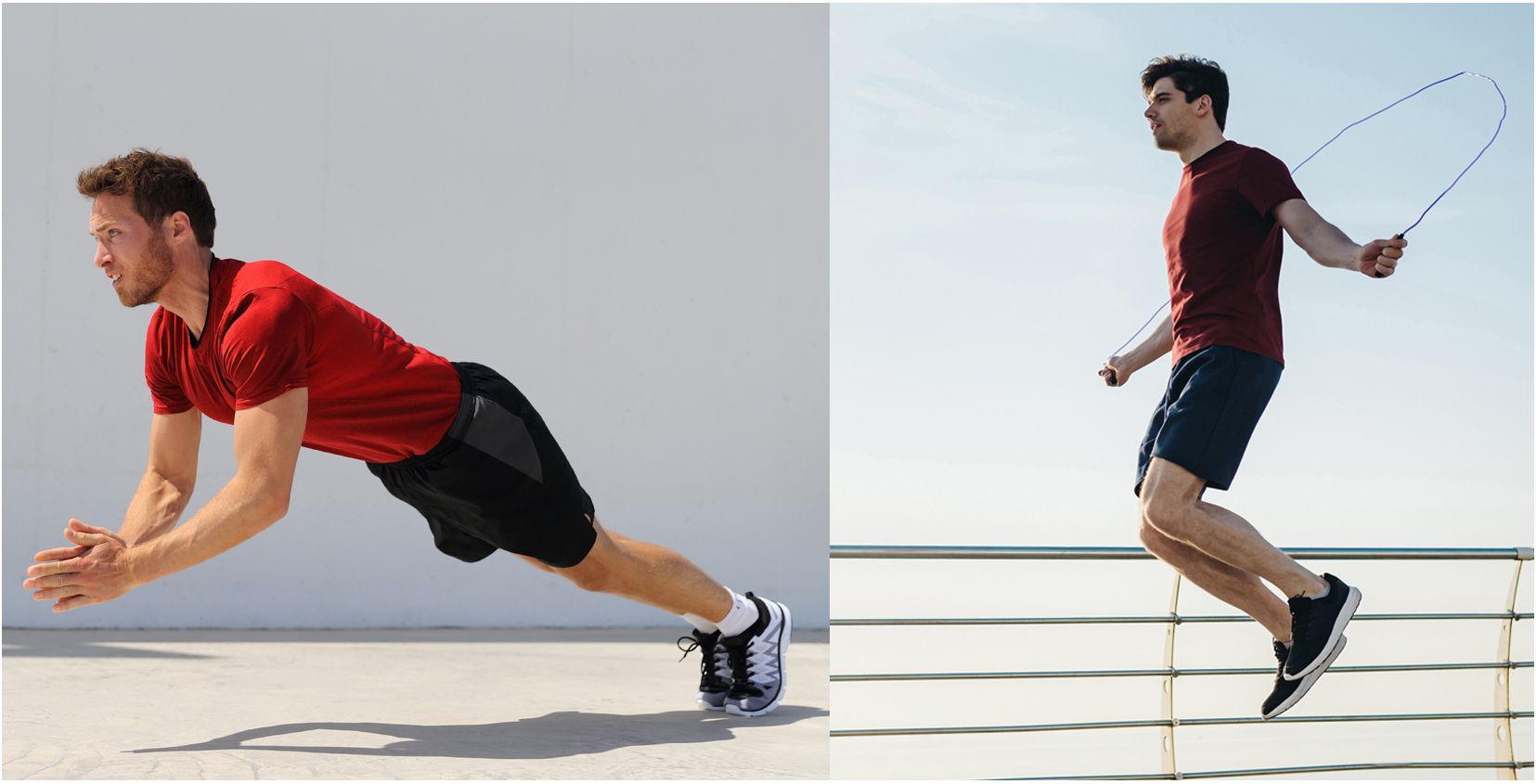
Although many coaches are aware of the benefits of the SSC, and understand that plyometric training enhances SSC (amongst other benefits as discussed above), assessment of athletes’ competency to utilise the SSC is often neglected. Simple methods are available, and require metrics that many coaches often already collect.
One method to identify the use of SSC is the assessment of pre-stretch augmentation (PSA) (calculation below). PSA, represented as a percentage, utilises the countermovement jump (CMJ) and the squat jump (SQJ) to determine the percentage of pre-stretch augmentation achieved, indicating the efficiency of the SSC by the respective athlete. Such comparisons require exercises that feature a pre-stretch and, therefore, utilisation of the SSC (eg, CMJ) compared to jumping activities absent of any pre-stretch or SSC usage (eg, SQJ).

Alternatively, the eccentric utilisation ratio (EUR) provides a ratio that similarly informs coaches whether their athletes are competently utilising the SSC, while also being associated with monitoring readiness.16 The EUR is a simple ratio of CMJ performance and SQJ performance. Scores equal or less than one are reflective of poor SSC utilisation, while those above one are indicative of effective SSC usage. Conversely, recent research16 has challenged whether high ratios of EUR are reflective of higher performance, stressing this may in fact pertain to poor squat jump ability. Regardless, the use of EUR to investigate initial SSC utilisation (ie, is the ratio above 1?) still seems worthwhile.
Interestingly, research27 comparing both the PSA and EUR established perfect associations between models, suggesting both display SSC competency in different manners (percentage versus ratio). Therefore, practitioners may be best positioned opting for one metric over the other, given no further findings will be established using both.
In addition to PSA% and EUR, reactive strength index (RSI) has gained popularity amongst practitioners for its ability to indicate SSC performance through a ratio of ground contact time and jump height.9 RSI takes into account the time element of the SSC which EUR and %PSA do not, aiding in a practitioner’s ability to understand how their athletes use the SSC.27 This can be measured using a variety of apparatus including force plates, jump mats and inertial measurement units (IMUs). However, practitioners should consider how RSI is formulated when choosing to monitor this metric, given both an increase in jump height and decrease in contact time can raise the RSI value. To circumvent such issues, both sides of the equation should be monitored with speed thresholds in mind so as to train and assess the correct SSC speeds.9 An example of this would be that RSI can be heavily augmented by small increases in contact time, leading to large increases in jump height.

Flannagan & Conyms9 also suggest that a profile can be built with increasing heights of box jumps (while maintaining a fast SSC contact time and correct exercise technique) to determine a critical threshold of performance. The profile demonstrates a point whereby the eccentric force generating capacity and pre-activation of the engaged musculature becomes insufficient, and also where the inhibitory mechanisms within the Golgi tendon organ protect the system. In turn, this informs the practitioner towards an optimal box height to invoke enough stress to cause adaptation, but – more importantly – to guide the practitioner’s decision-making into the intensity of other plyometrics chosen within a programme to apply a sufficient stimulus. This method was completed within a recent study18 and demonstrates well its ability to build a profile. However, although this type of profiling has been presented within work by Montoro-Bombú18 and Flanagan & Conyms,9 we lack an extensive literature base for this profiling and it therefore warrants further exploration.
Gauging an understanding towards your athlete’s ability to utilise the SSC will offer guidance towards programme prescriptions. If SSC appears low, practitioners should consider if the correct dosages (ie, sufficient stimulus for adaptation) or exercises (ie, are the correct movement strategies being employed?) are being prescribed. Therein lies a further common issue, with the lack of understanding towards developing a progressive structure to plyometric exercises.
The application of exercise continuums provides a logical sequence of progression for athletes to pursue. Work undertaken by Suchomel et al28 provides guidance towards how such continuums may be organised for plyometric exercises (see Figure 1).
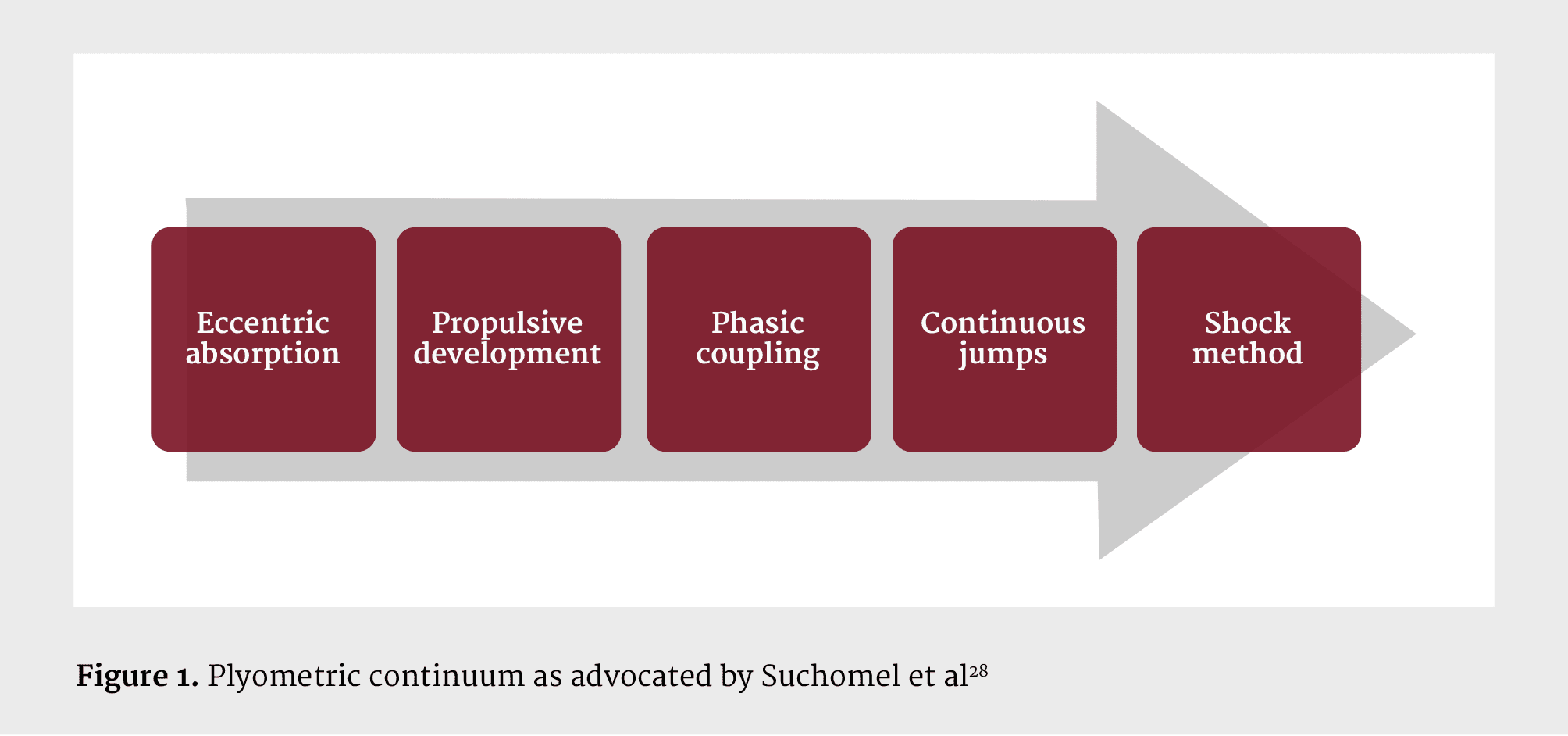
Eccentric absorption accounts for landing tasks, whereby athletes are required to produce adequate eccentric forces to deal with landing impact, while maintaining limb alignment. Propulsive development consists of a focus now placed upon force generation, while minimising landing demands where possible. Phasic couple introduces equal demands on both propulsive force output and eccentric capacities. Continuous jumps extend this into repeated jumps with minimal ground contact times. Finally, the shock method consists of an overload in eccentric demand, whereby a ‘collision’ with the ground occurs due to an elevated start position (eg, from a box), followed by an immediate propulsion.
Common criticisms of the above continuum typically extend to questions such as ‘when do you ever stick a landing within sport?’. Such comments imply that plyometric training, if not all training, must represent sporting movement, and therefore must adhere to specificity. However, we must instead look at plyometrics as more complex movements than we perhaps credit them for, and therefore the continuum is a method of breaking down this movement into smaller, more manageable components, to enhance learning. Additionally, large exposures to eccentric stress (from plyometrics) should be methodically and incrementally planned, further warranting such continuums. A lack of such considerations may result in under-stimulation and prolonged adaptation due to poor economy of movement and utilisation of the SSC, if not the ingraining of poor mechanics related to injury (eg, knee valgus-related issues).
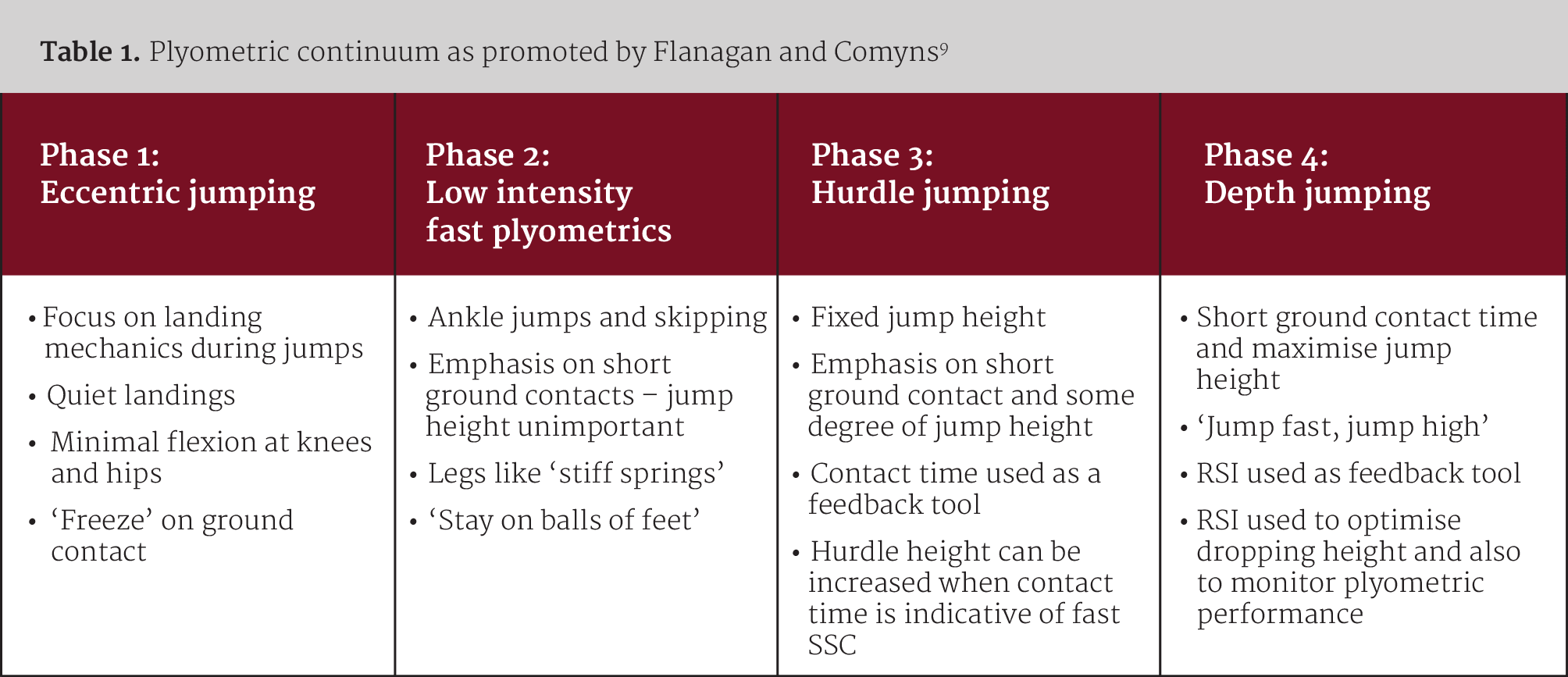
In contrast to Suchomel et al,28 a model previously proposed by Flanagan and Comyns9 (see Figure 2) may answer some of the criticisms that lie within the omission of reactive elements in the first stages of the continuum. Low intensity plyometrics may provide a more isolated stimulus to the ankle/calf complex, at low amplitudes which help to bridge the gap between slower SSC jumps and faster and higher amplitude SSC jumping, which the study by Suchomel et al28 may miss, or not implement as early as they could be. There are positives and negatives to both continuums and readers should understand that continuums are there to implement a logical, load-based approach, to ensure safety and adaptation. Therefore, a mix of these approaches with rationalised decision-making around progression criterion would be advised.
Although anecdotal, an exercise continuum has been provided below, considering a blend of the above discussed models, so as to provide further guidance and considerations for practitioners. The continuum outlines a progression by training phase and sub-phase variables to highlight the variations that exist. Exercise examples have been provided, as has the aim of the phase: to further outline and clarify the training focus. As authors, we believe this continuum provides simple and clear guidance towards the use of plyometric exercises. However, we appreciate a vast array of exercises exist beyond what is stated, and would encourage others to build upon the continuum.

A final point: given the abovementioned continuum, it is evident that not all plyometrics are made equal. Some plyometric exercises are commonly considered low demand/intensity, such as pogos/ankling, whereas other exercises such as depth jumps are frequently discussed as high demand/intensity. Therefore, multiple qualities can be trained simultaneously (eg, pogos and box jumps) without the risk of negative impacts. Likewise, work from Suchomel et al29 provides context around athlete competencies (ie, relative lower body strength) to undertake varying plyometric exercises. We refer readers to Suchomel’s research for further reading and for the relative strength thresholds for plyometric exposure.28,29
Logic needs to be applied, therefore, when programming plyometrics, to consider the required ground contacts for adaptation to take place, while also considering the level of plyometric exercises being implemented, so as not to cause excessive and unnecessary delayed onset of muscle soreness (DOMS) and increased risk of injury (as alluded to earlier).
Plyometric exercises are some of the most commonly applied exercise interventions within strength and conditioning, and for good reason. However, practitioners may find themselves achieving sub-optimal outcomes if they do not fully understand the mechanisms involved in plyometric training, and what adaptations are to be expected. Likewise, common pitfalls in implementing plyometrics include a failure to acknowledge incorrect movement strategies, poor prescriptions of exercises and misunderstandings towards exercise progressions. Therefore, this article has attempted to provide insights and guidance in order to enhance practitioner engagement with plyometric exercises.
1. Alemdaroǧlu, U, Dündar, U, Köklü, Y, Aşci, A, and Findikoǧlu, G. The effect of exercise order incorporating plyometric and resistance training on isokinetic leg strength and vertical jump performance: A comparative study. Isokinet Exerc Sci, 21: 211–217. 2013.
2. Andrade, DC, Manzo, O, Beltrán, AR, Álvarez, C, Del Rio, R, Toledo, C, et al. Kinematic and Neuromuscular Measures of Intensity During Plyometric Jumps. J Strength Cond Res, 34: 3395–3402. 2020.
3. Brazier, J, Maloney, S, Bishop, C, Read, PJ, and Turner, AN. Lower Extremity Stiffness: Considerations for Testing, Performance Enhancement, and Injury Risk. J Strength Cond Res, 33: 1156–1166. 2019.Available from: https://journals.lww.com/00124278-201904000-00028
4. Chaouachi, M, Granacher, U, Makhlouf, I, Hammami, R, Behm, DG, and Chaouachi, A. Within session sequence of balance and plyometric exercises does not affect training adaptations with youth soccer athletes. J Sport Sci Med, 16: 125–136. 2017.
5. Dallas, GC, Pappas, P, Ntallas, CG, Paradisis, GP, and Exell, TA. The effect of four weeks of plyometric training on reactive strength index and leg stiffness is sport dependent. J Sports Med Phys Fitness, 60: 9–15. 2020. Available from: https://www.minervamedica.it/index2.php?show=R40Y2020N07A0979
6. Dechiara, T, Neahous, S, and Ebben, WP. KINETIC ANALYSIS OF HORIZONTAL PLYOMETRIC EXERCISE INTENSITY Andrew J . Kossow , Tyler G . DeChiara , Steve M . Neahous , and William P . Ebben Department of Health , Exercise Science & Sport Management , University of. 709–712. 2013.
7. Deutsch, M and Lloyd, R. Effect of order of exercise on performance during a complex training session in rugby players. J Sports Sci, 26: 803–809. 2008.
8. Ebben, WP. Plyometric Intensity. NSCA’s Perform Train J, 6: 12–16. 2007.
9. Flanagan, EP and Comyns, TM. The Use of Contact Time and the Reactive Strength Index to Optimize Fast Stretch-Shortening Cycle Training. Strength Cond J, 30: 32–38. 2008.Available from: https://journals.lww.com/00126548-200810000-00005
10. Grgic, J, Schoenfeld, BJ, and Mikulic, P. Effects of plyometric vs. resistance training on skeletal muscle hypertrophy: A review. J Sport Heal Sci, 10: 530–536. 2021.Available from: https://doi.org/10.1016/j.jshs.2020.06.010
11. Ho, IMK, Wong, TS, Yong, JTH, and Fang, H. Plyometric stress index: A novel method for quantifying plyometric training. Sci Sport, 37: 788–797. 2022.
12. Janikov, MT, Pádecký, J, Doguet, V, and Tufano, JJ. Countermovement, Hurdle, and Box Jumps: Data-Driven Exercise Selection. J Funct Morphol Kinesiol, 8. 2023.
13. Jarvis, MM, Graham-Smith, P, and Comfort, P. A methodological approach to quantifying plyometric intensity. J Strength Cond Res, 30: 2522–2532. 2016.
14. Jensen, RL and Ebben, WP. Ground and Knee Joint Reaction Forces During Variations. Program 373–376. 2005.
15. Jidovtseff, B, Quievre, J, Harris, NK, and Cronin, JB. Influence of jumping strategy on kinetic and kinematic variables. J Sports Med Phys Fitness, 54: 129–138. 2014.
16. Kozinc, Ž, Smajla, D, and Šarabon, N. Is larger eccentric utilization ratio associated with poorer rate of force development in squat jump ? An exploratory study. Int Biomech, 11: 1–5. 2024. Available from: https://doi.org/10.1080/23335432.2024.2341634
17. Makaruk, H, Porter, JM, Czaplicki, A, Sadowski, J, and Sacewicz, T. The role of attentional focus in plyometric training. J Sports Med Phys Fitness, 52: 319–327. 2012.
18. Montoro-Bombú, R, Sarmento, H, Elferink-Gemser, MT, Costa, A, Malico Sousa, P, and Rama, L. The Integral Reactive Strength Index: An Accurate Measurement for Evaluating Drop Jump Performance in Sprinter Athletes. Appl Sci, 14: 4964. 2024. Available from: https://www.mdpi.com/2076-3417/14/12/4964
19. Phillips, JH and Flanagan, SP. Effect of Ankle Joint Contact Angle and Ground Contact Time on Depth Jump Performance. J Strength Cond Res, 29: 3143–3148. 2015. Available from: https://journals.lww.com/00124278-201511000-00019
20. Potach, D and Chu, D. Plyometric training. In: Essentials of Strength and Conditioning. Earle, R, ed. . Champaign, OI: Human Kinetics, 2000 [cited 2024 May 23]. pp. 427–470.
21. Ramirez-Campillo, R, Garcia-Pinillos, F, Chaabene, H, Moran, J, Behm, DG, and Granacher, U. Effects of plyometric jump training on electromyographic activity and its relationship to strength and jump performance in healthy trained and untrained populations: a systematic review of randomized controlled trials. J Strength Cond Res, 35: 2053–2065. 2021.
22. Ramirez-Campillo, R, García-Pinillos, F, Nikolaidis, PT, Clemente, FM, Gentil, P, and García-Hermoso, A. Body composition adaptations to lower-body plyometric training: A systematic review and meta-analysis. Biol Sport, 39: 273–287. 2022.
23. Ramirez-Campillo, R, Moran, J, Drury, B, Williams, M, Keogh, JW, Chaabene, H, et al. Effects of equal volume but different plyometric jump training intensities on components of physical fitness in physically active young males. J Strength Cond Res, 35: 1916–1923. 2021.
24. Ramírez-delaCruz, M, Bravo-Sánchez, A, Esteban-García, P, Jiménez, F, and Abián-Vicén, J. Effects of Plyometric Training on Lower Body Muscle Architecture, Tendon Structure, Stiffness and Physical Performance: A Systematic Review and Meta-analysis. Sport Med Open 8. 2022.
25. Seiberl, W, Hahn, D, Power, GA, Fletcher, JR, and Siebert, T. Editorial: The Stretch-Shortening Cycle of Active Muscle and Muscle-Tendon Complex: What, Why and How It Increases Muscle Performance? Front Physiol, 12: 10–13. 2021.
26. Smith, JP, Kernozek, TW, Kline, DE, and Wright, GA. Kinematic and Kinetic Variations Among Three Depth Jump Conditions in Male NCAA Division III Athletes. J Strength Cond Res, 25: 94–102. 2011. Available from: https://journals.lww.com/00124278-201101000-00014
27. Suchomel, TJ, Sole, CJ, Citadel, T, and Stone, MH. Comparison of Methods That Assess Lower-body Stretch-Shortening Cycle Utilization. 2015.
28. Suchomel, TJ, Wagle, JP, Douglas, J, Taber, CB, Harden, M, Gregory Haff, G, et al. Implementing eccentric resistance training—Part 1: A brief review of existing methods. J Funct Morphol Kinesiol, 4: 1–25. 2019.
29. Suchomel, TJ, Wagle, JP, Douglas, J, Taber, CB, Harden, M, Gregory Haff, G, et al. Implementing eccentric resistance training—Part 2: Practical recommendations. J Funct Morphol Kinesiol, 4. 2019.
30. Thomas, K, French, D, and Hayes, PR. The effect of two plyometric training techniques on muscular power and agility in youth soccer players. J Strength Cond Res, 23: 332–335. 2009.
31. Van Den Tillaar, R, Roaas, TV, and Oranchuk, D. Comparison of effects of training order of explosive strength and plyometrics training on different physical abilities in adolescent handball players. Biol Sport, 37: 239–246. 2020.
32. Turner, AN and Comfort, P. Advanced Strength and Conditioning. 2022.
33. Turner, AN and Jeffreys, I. The stretch-shortening cycle: Proposed mechanisms and methods for enhancement. Strength Cond J, 32: 87–99. 2010.
34. Wallace, BJ, Kernozek, TW, White, JM, Kline, DE, Wright, GA, Peng, H Te, et al. Quantification of vertical ground reaction forces of popular bilateral plyometric exercises. J Strength Cond Res, 24: 207–212. 2010.
35. Watkins, CM, Gill, ND, Maunder, E, Downes, P, Young, JD, McGuigan, MR, et al. The Effect of Low-Volume Preseason Plyometric Training on Force-Velocity Profiles in Semiprofessional Rugby Union Players. J Strength Cond Res, 35: 604–615. 2021.
36. Watkins, CM, Storey, AG, McGuigan, MR, and Gill, ND. Implementation and Efficacy of Plyometric Training: Bridging the Gap between Practice and Research. J Strength Cond Res, 35: 1244–1255. 2021.
37. Weldon, A, Duncan, MJ, Turner, A, Laplaca, D, Sampaio, J, and Christie, CJ. Practices of Strength and Conditioning Coaches: A Snapshot From Different Sports, Countries, and Expertise Levels. J Strength Cond Res, 36: 1335–1344. 2022.
38. Weldon, A, Duncan, MJ, Turner, A, Lockie, RG, and Loturco, I. Practices of strength and conditioning coaches in professional sports: A systematic review. Biol Sport, 39: 715–726. 2022.
39. Wilson, JM and Flanagan, EP. The role of elastic energy in activities with high force and power requirements: A brief review. J Strength Cond Res, 22: 1705–1715. 2008.

Dr Rich Kite, ASCC, CSci, is a lecturer in strength and conditioning at Bournemouth University. Having attained over a decade of experience working in industry with youth athletes, his research lies within youth and talent development, as well as further interests in plyometric training.

Jourdain has a MSc and currently coaches elite level athletes across a variety of sports; he has a keen interest in diagnostics for physical profiling.

